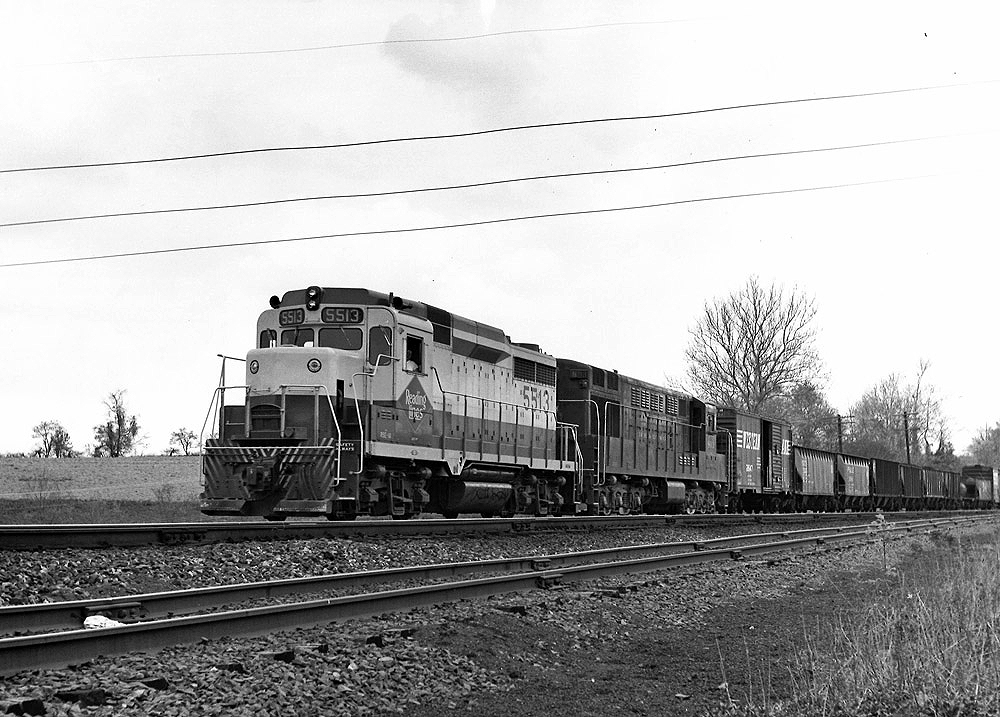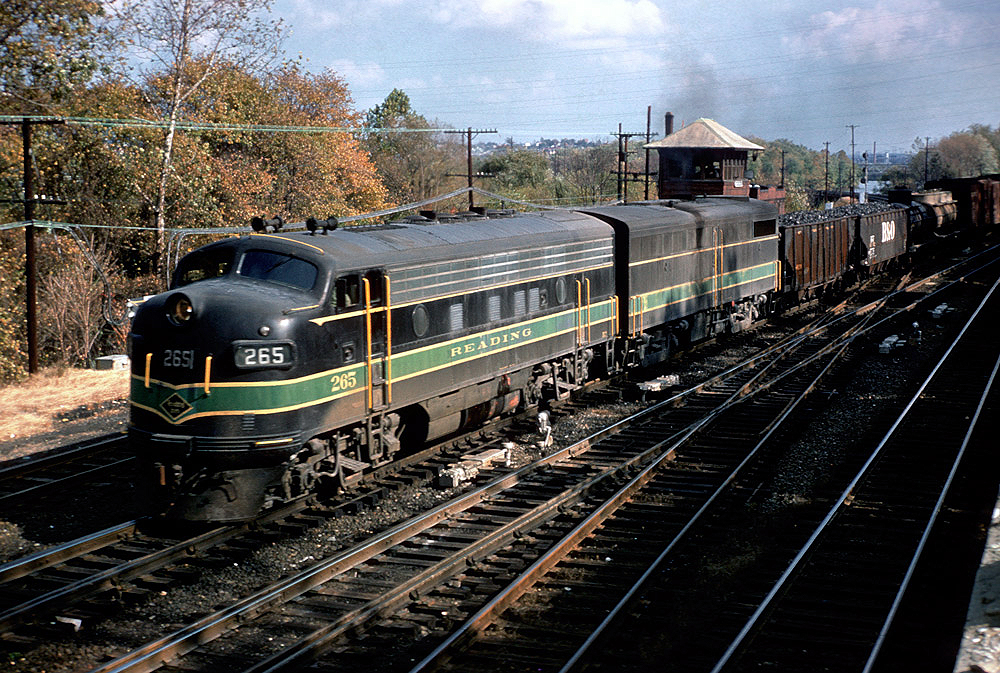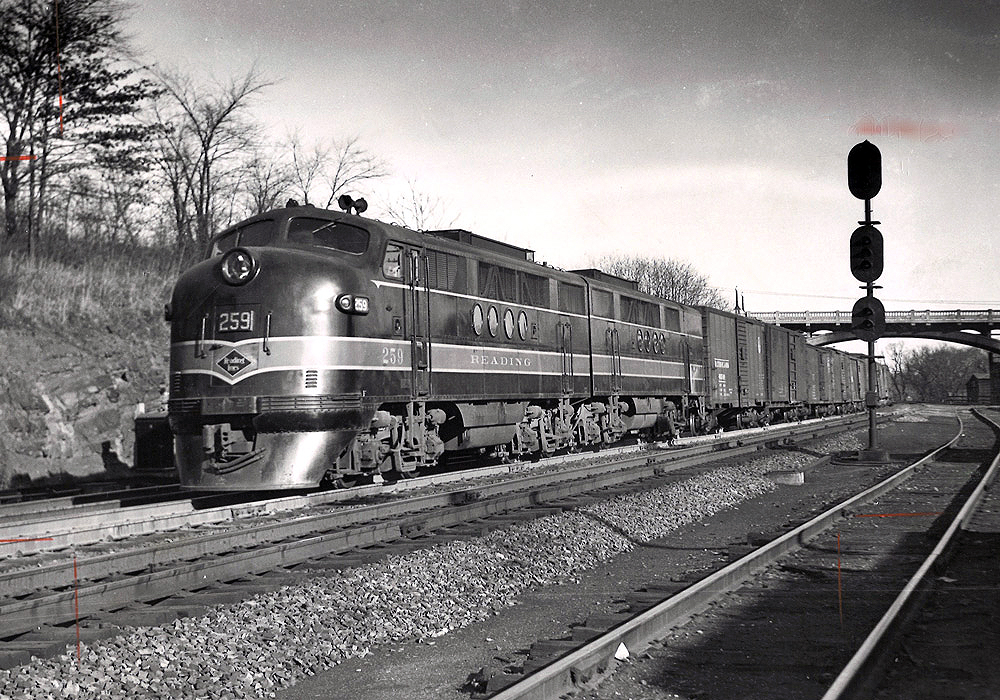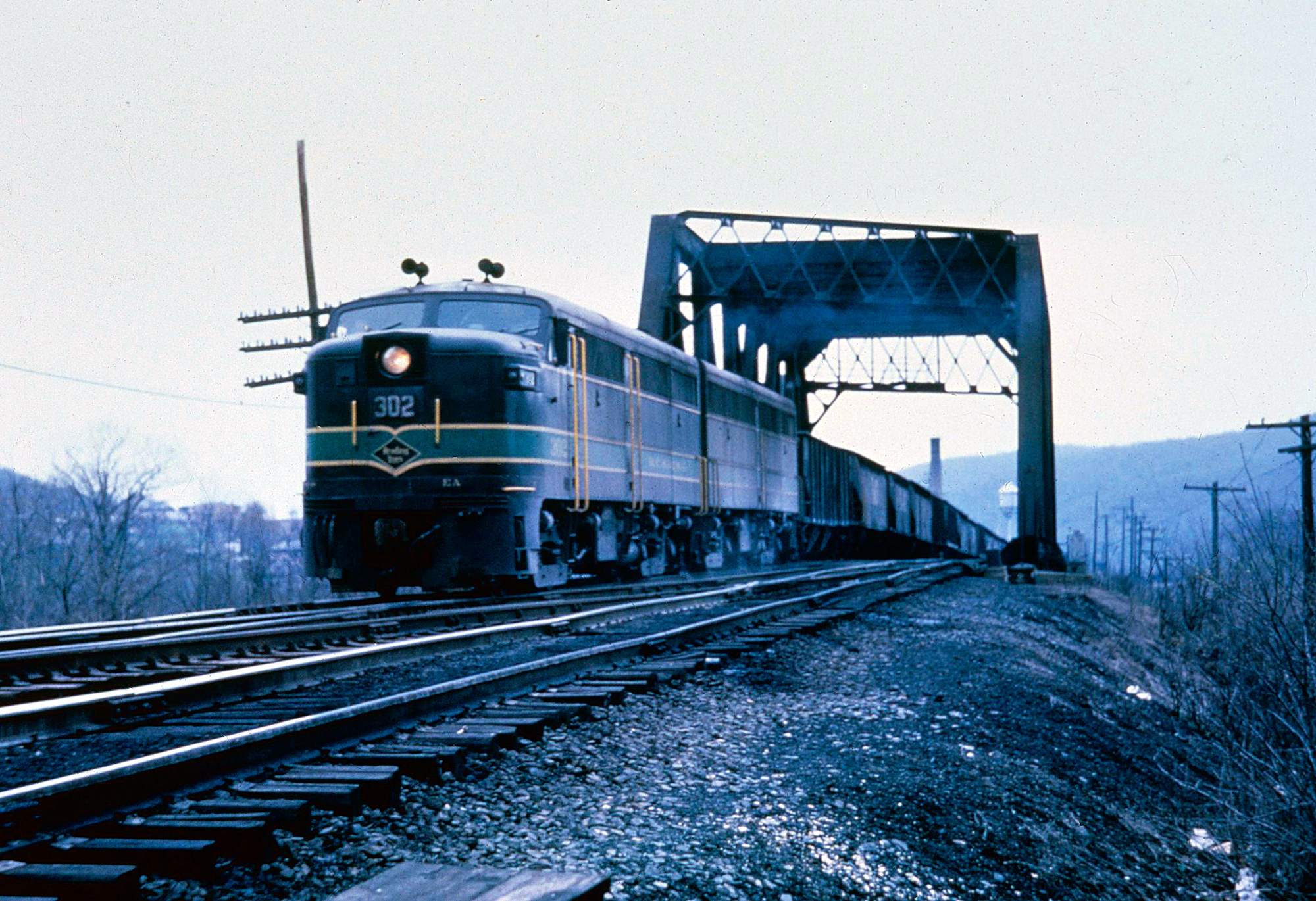
NickD
MegaDork
9/11/23 12:51 p.m.
Brand-new GP30 #5513 and Fairbanks-Morse H24-66 #803 lead a mixed freight west out of Rutherford Yard on the east side of Harrisburg, PA, in April 1962. The train is likely bound for Hagerstown, Md., and a connection with the Western Maryland. The F-M Train Master wears the original Reading road switcher livery of Pullman green paint scheme with yellow Reading lettering and end and corner handrails painted yellow for safety. The GP30s, often deemed the first second-generation diesel locomotives, were the first units to be delivered in the new bright yellow and green livery. The pictured GP30, #5513, actually still exists. It was renumbered in 1964 to #3613, when Reading renumbered all their GP30s in line with the Baltimore & Ohio's numbering system, because there was talks of B&O fully taking control of the Reading. It wouldn't actually happen, but it kept the new number until 1976. Conrail renumbered the #5513/#3613 to #2181, although it would keep the Reading green and yellow until retirement. It was stored at Rutherford Yard until 1985, and Conrail then sold it to the RCT&HS, becoming the first locomotive in their collection. They had access to the original Reading shops in Reading, PA and restored it there, and operated it on a number of excursions over the Blue Mountain & Reading, usually paired with Reading Alco C630 #5308, until 1991, when a failing turbocharger clutch prompted them to remove it from service.


NickD
MegaDork
9/11/23 2:28 p.m.
Reading F7A #265 and an Alco FB on a westbound mixed freight pass the tower at Bridgeport, PA, where Reading’s passenger line from Philadelphia up the north bank of the Schuylkill River joined the main line on the south bank.


NickD
MegaDork
9/11/23 2:31 p.m.
An A-B set of EMD FTs passes passes Birdsboro, PA, with symbol freight PN5 (Philadelphia–Newberry Junction) , in November 1948.


NickD
MegaDork
9/11/23 2:33 p.m.
An Alco FA-FB set pass through Allentown with a set of empty cars.


NickD
MegaDork
9/11/23 2:49 p.m.
Freight F-7 units arrive on the Main Line at Reading, PA, having come fromthe Shamokin Division, while another with empty hopper cars has just descended the East Penn Branch Hill Line from points east


NickD
MegaDork
9/11/23 2:56 p.m.
Reading RS-3 #470 with two passenger cars at Newtown Junction, in October, 1961


NickD
MegaDork
9/11/23 3:27 p.m.
Reading Company's Phoenixville tunnel and Schuylkill River bridge in double-tracked days, sometime in August of 1951. That's train #7 Schuylkill exiting the tunnel, with big G-3 Pacific #212 leading the 7-car train. The G-3s were the last Pacifics built in the US for US usage, being constructed in the railroad's own shops, under great secrecy, in 1948. Why the Reading chose to construct new steam locomotives at a time when the railroad was already buying in on diesels remains a mystery. But, they took the basic design of the G-2, put 80" drivers under a cast steel frame, increased the operating pressure to 260psi, and added a Worthington 5A feed water heater. The result was an engine that, while questionable in aesthetics, was a very solid performer and didn't need much fiddling or sorting out, other than adding a Boxpok disc driver set on the center drive axle to withstand the boiler pressure, which increased strain on the main driver, as well as the need to balance the main rod's effect.


NickD
MegaDork
9/11/23 3:35 p.m.
The Reading's big Mallets, class N-1. These 2-8-8-2s were built in 1919 with the "clear the entire yard in one trip" mentality of the era. It didn't matter if they coul;d only do 5-10mph, they just had to haul every car hooked to them. Even with the absolutely enormous grate and combustion chamber of the huge Wooten firebox, these engines were still short of breath and their duty primary duty was typically in helper service on some of the Reading's 3% grades. The class was broken up in the late-1920s when the first eleven engines of the N1-sas were converted to K1-sa and K1-sc Santa Fe-type 2-10-2s. The remaining compounds were redesignated N1-sb (1816-1830) if they had Standard stokers and N1-sc (1811-1815) if they used the Street Duplex stoke, and all of these were fitted with Nicholson thermic syphons at the same time. All but one of the twenty remaining engines were eventually rebuilt as N1-sd simple-expansion articulateds starting in 1940, and they also had their trailing truck removed, becoming 2-8-8-0s, in the same timespan. The idea behind removing the trailing truck was to add weight on the drive wheels and increase tractive effort.



NickD
MegaDork
9/11/23 3:38 p.m.
Reading #903 at Shamokin, PA with eastbound train number #6 to Reading Terminal. A joke among Reading conductors when asked by passengers if there was a smoking car was to reply "Yes, it has a Shamokin car", implying it had a car in the consist that offered a connection to Shamokin. The photo is definitely post 1960, judging my the 1960 Ford full-size on the left, but pre-1965. The passenger station (left of tracks) was demolished in October of 1965, and the freight house (right of tracks) demolished March of 1966


NickD
MegaDork
9/11/23 3:45 p.m.
Reading G-2 Pacific #177 with what looks like a Main Line (Philadelphia-Pottsville) train crossing the Schuylkill River, possibly headed towards Black Rock Tunnel and Phoenixville, PA


NickD
MegaDork
9/11/23 3:59 p.m.
This big 80" drivered speed demon is one of the Reading's intriguing P-7sb rear-cab Atlantics, the only Atlantics owned by the Reading that weren't Camelbacks (they had some of those with 86" drivers!). They had originally been built as the C1-a class 4-4-4s, also rear-cab locomotives, but, like pretty much every railroad that experimented with the 4-4-4 wheel arrangement, the Reading rapidly discovered that the wheel arrangement was fundamentally flawed. The Reading's experimental 4-point suspension, different from the typical 3-point "milking stool" arrangement used on every other steam locomotive, added to the troubles, and in rather short order, Reading rebuilt the C1-as into the P7-sbs, which were much, much more successful. The #353, the final of the four, was captured at the coaling facility in Philadelphia


NickD
MegaDork
9/11/23 4:32 p.m.
Reading K-1sa 2-10-2 #3001, one of the ten rebuilt from the N1-sa Mallets, at the servicing facility at the Shamokin Yard in April, 1953. Likely the last or one of the very last K-1 locomotives in use at that late date, the K-1sas were a monster of a locomotive, the biggest and heaviest Santa Fes ever built.


NickD
MegaDork
9/11/23 4:33 p.m.
Coming down off the East Penn Branch Hill Line before the Blandon Cutoff was built, this freight train led by two GP7s is typical of Reading Company freight operations in this March, 1953 photo. Taken from the employee foot bridge located near Pike Street in Reading, PA


NickD
MegaDork
9/11/23 4:35 p.m.
Reading Company FT set under the overhead rope telltales along the Reading Belt Line at Valley Junction in Wyomissing, PA in March 1953. The track to the left connects to Lebanon Valley Branch while this train may be a Allentown-Abrams Yard late afternoon train


NickD
MegaDork
9/11/23 4:36 p.m.
Brand new Reading RS-3s #460 and #464 with a good-sized train near 16th Street, Philadelphia. That line overhead with the EMU cars on it is the PRR Chestnut Hill Line. Particularly intriguing is that those are Lehigh Valley coaches behind the RS-3s.


NickD
MegaDork
9/11/23 4:52 p.m.
A six-car set of Reading EMU cars passing through Wayne Junction. Five of them are the original unrebuilt cars, still in Reading dark green, while the rear car, #9111, was part of a 38-car rebuilding program between 1963 and 1965, which were christened Blueliners for the new blue and white paint they received afterwards.


NickD
MegaDork
9/11/23 4:53 p.m.
A three-car set of Blueliners, also at Wayne Junction. Over the top of the headlight, the thing with the big wide foot, is the bus bar that automatically made a connection as soon as the cars were coupled.


NickD
MegaDork
9/11/23 4:55 p.m.
Reading RDCs near Wayne Junction in 1975, with high-visibility striping on the ends. Even up to the bitter end, the Reading kept their equipment well cleaned.


NickD
MegaDork
9/12/23 9:18 a.m.
Two of the big T-1s, #2100 and #2124, used for the Reading Iron Horse Rambles between 1959 and 1964. There were three others, with #2102 also seeing use, #2101 kept as standby but never used, and #2123 as a parts source. At the time they were begun, the Iron Horse Rambles were unlike anything else that was being done across the nation. Most other railroads were scrapping or retiring the last of their steam locomotives, even UP #844 was sitting on the deadlines before being converted for melting snow and ice out of switches. But the Reading, who had a long history of running fantrips, grabbed five of their big Northerns out of retirement, cleaned them up, and put them to work hauling excursions, often doubleheaded. Since they were run over Reading rails by Reading employees with Reading equipment, and the physical infrastructure was still pretty good, it was noted that these trips almost always ran flawlessly, unlike a lot of railfan-hosted trips of that era. That's the original Reading Outer Station in the background, which was quite an impressive structure for the era and at one point had sheds over all the tracks. It was closed down in March of 1969, after the joint Reading-CNJ Queen Of The Valley was discontinued, which was the last medium distance route to pass through the city from Jersey City to Harrisburg. The structure was boarded up but still quite intact when it mysteriously burned in 1978. As someone remarked, a lot of old structures mysteriously burned in the early Conrail days, to a suspicious degree. Likely an easy way to get rid of the buildings for free and not have to pay taxes on them,


NickD
MegaDork
9/12/23 10:01 a.m.
A fascinating little Maintenance of Way hi-rail work van/truck. The front end smacks of Ford Vanette, while the rest of it was reported to have been built by Boyertown Body Works, which was a truck body builder that was based out of Boyertown, PA on the Reading Colebrookdale Branch (today the operating hub of the Colebrookdale Railroad)


NickD
MegaDork
9/12/23 10:15 a.m.
Reading Company FT set #258 is westbound on the Lebanon Valley Branch bridge over the Schuylkill River, leaving Reading, PA. It's crossing over Reading Belt Line trackage with American Chain & Cable Co. and old Vanity Fair building on Schuylkill Avenue showing in the background.


NickD
MegaDork
9/12/23 10:39 a.m.
Fresh out of the Reading shops, Pacific #121 poses for a photo in 1924. She had just had a superheater added, converting her from a G1 to a G1-sa






















































